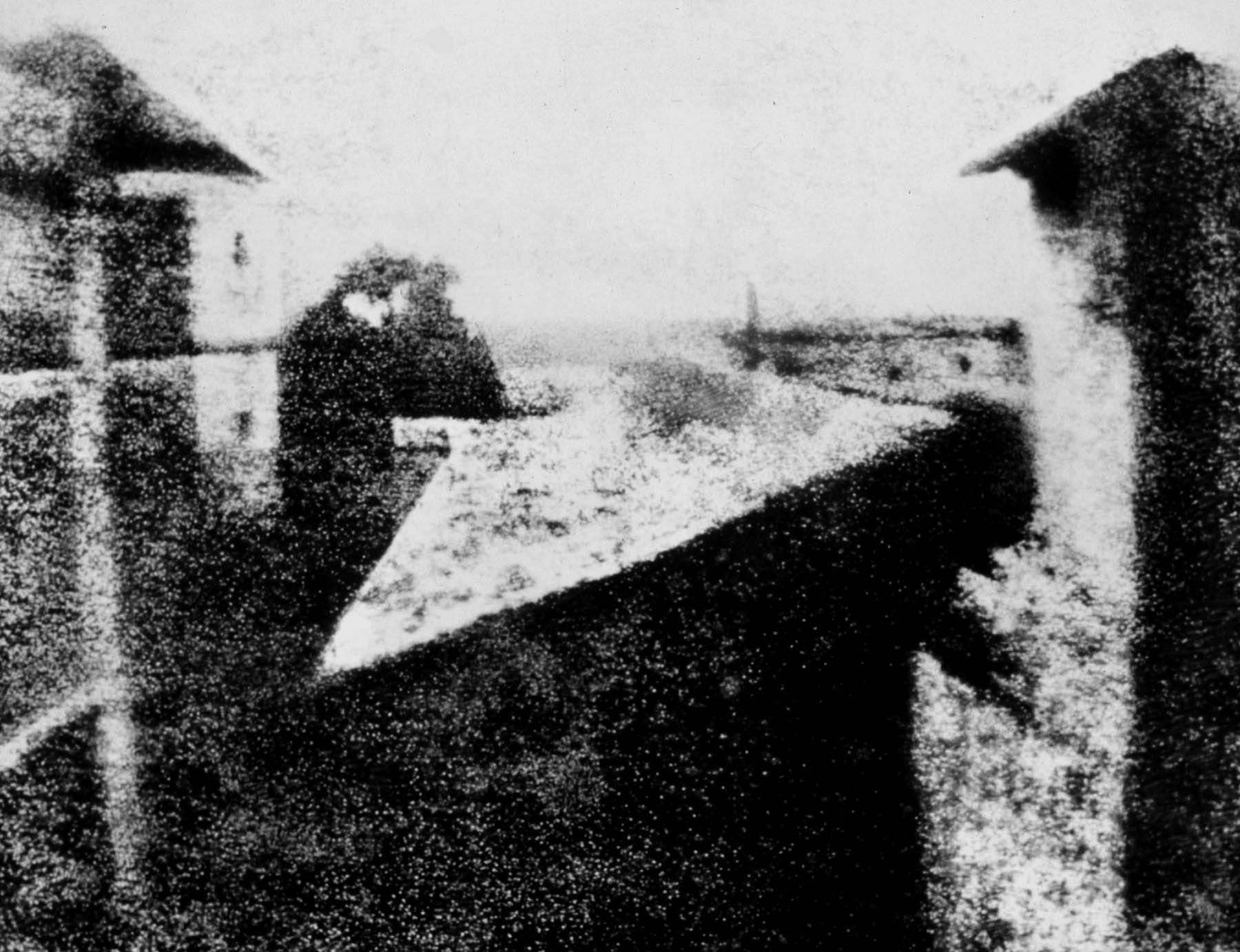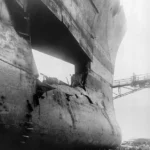Photography has become an integral part of modern life, but its origins trace back to a groundbreaking moment in the early 19th century. The first permanent photograph, known as “View from the Window at Le Gras,” was created by Joseph Nicéphore Niépce in 1826 or 1827.
Niépce’s historic image required an exposure time of approximately eight hours, capturing a view from an upstairs window at his estate in France. This lengthy process was a far cry from the instant snapshots we’re accustomed to today. The image was produced on a pewter plate coated with bitumen, a naturally occurring petroleum tar.
The story behind this pioneering photograph involves years of experimentation and determination. Niépce’s success paved the way for rapid advancements in photographic technology, leading to the development of more practical methods by innovators like Louis Daguerre and Henry Fox Talbot.
Origins of Photography
Photography emerged from a convergence of scientific discoveries and artistic ambitions in the early 19th century. Inventors and tinkerers experimented with light-sensitive materials and optical devices to capture permanent images.
Early Experiments
The camera obscura, a darkened room or box with a small hole that projected an inverted image, had been known since ancient times. Artists used it as a drawing aid. In the 1600s, portable versions were developed.
Chemical experiments in the late 1700s revealed that certain silver compounds darkened when exposed to light. This laid the groundwork for photographic processes.
In 1802, Thomas Wedgwood created temporary sun prints of leaves on leather treated with silver nitrate. His images faded quickly when exposed to light.
The Quest for Permanence
Inventors sought ways to fix ephemeral images and make them permanent. Various methods were attempted using different light-sensitive materials.
In 1819, John Herschel discovered that sodium thiosulfate could dissolve silver salts. This “fixer” became crucial for stabilizing photographs.
Louis Daguerre experimented with silver-plated copper sheets treated with iodine vapor. His daguerreotypes produced detailed images but were fragile and couldn’t be duplicated.
Joseph Nicéphore Niépce
French inventor Joseph Nicéphore Niépce made breakthrough advancements in photography during the 1820s. He experimented with various techniques to create permanent images.
In 1822, Niépce successfully created a photograph on a pewter plate coated with bitumen. The exposure took eight hours.
His most famous image, “View from the Window at Le Gras,” was created in 1826 or 1827. It’s considered the oldest surviving photograph.
Niépce called his process “heliography.” He later partnered with Daguerre to refine photographic techniques.
The First Photograph
The first permanent photograph marked a revolutionary moment in visual history. It captured a view from a window and utilized an innovative chemical process to fix the image.
View from the Window at Le Gras
Joseph Nicéphore Niépce created the world’s first photograph in 1826 or 1827. Titled “View from the Window at Le Gras,” it depicted the scene from an upstairs window at his estate in Saint-Loup-de-Varennes, France.
The image shows rooftops, outbuildings, and the surrounding landscape. Due to the long exposure time, estimated between 8 hours and several days, the sun appears to shine on both sides of the buildings.
This pioneering photograph was created on a pewter plate coated with bitumen. It measures 16.2 cm × 20.2 cm (6.4 in × 8 in).
Heliography Process
Niépce developed the heliography process to create the first photograph. This technique involved coating a pewter plate with bitumen, a naturally occurring petroleum tar.
The coated plate was then placed in a camera obscura and exposed to light for several hours. Areas hit by light hardened, while shadowed areas remained soft.
After exposure, the plate was washed with a mixture of oil of lavender and white petroleum. This dissolved the unhardened bitumen, leaving a permanent image.
The process was time-consuming and produced low-quality results by modern standards. However, it laid the foundation for future photographic techniques.
Technological Innovations
The first photograph emerged from a series of groundbreaking technological advancements. These innovations paved the way for modern photography and imaging.
Louis Daguerre’s Contributions
Louis Daguerre revolutionized early photography with his daguerreotype process. This method used a silver-plated copper sheet treated with iodine vapor to create light-sensitive silver iodide. After exposure in a camera, the image was developed using mercury vapor and fixed with a salt solution.
Daguerre’s technique produced highly detailed images with a mirror-like surface. It significantly reduced exposure times from hours to minutes, making photography more practical. The daguerreotype became the first commercially successful photographic process, popularizing portrait photography in the 1840s and 1850s.
Evolution of Photographic Equipment
Early cameras were large, cumbersome devices known as camera obscuras. These evolved into more portable designs as photography gained popularity.
Key improvements included:
- Lens quality: Better optics allowed for sharper images and reduced distortion
- Shutters: Mechanical shutters enabled precise exposure control
- Light-sensitive materials: New chemicals increased sensitivity, reducing exposure times
- Portable designs: Folding cameras and smaller formats made photography more accessible
The introduction of flexible film by George Eastman in 1884 marked a major turning point. It replaced fragile glass plates, making cameras lighter and easier to use. This innovation led to the development of the Kodak camera in 1888, bringing photography to the masses.
Impact on Society
The invention of photography profoundly shaped modern society, influencing art, documentation, and mass media. It revolutionized how people perceived and recorded the world around them.
Art and Documentation
Photography transformed artistic expression and historical documentation. Artists embraced the new medium, incorporating photographic techniques into their work. Painters like Degas and Toulouse-Lautrec used photographs as references, while others experimented with photo-based art forms.
The ability to capture precise visual records changed how events were documented. Historical moments, previously reliant on written accounts or artistic interpretations, could now be preserved with unprecedented accuracy.
Photographs became invaluable tools for scientific research, allowing detailed study of natural phenomena and microscopic subjects. This visual evidence accelerated advancements in fields like biology, astronomy, and medicine.
The Growth of Mass Media
Photography played a crucial role in the expansion of mass media. Newspapers and magazines increasingly incorporated images, enhancing their storytelling capabilities and appeal to readers.
The rise of photojournalism brought world events into people’s homes. Iconic images from wars, natural disasters, and social movements shaped public opinion and influenced policy decisions.
Advertising embraced photography, using visually striking images to promote products and services. This visual approach revolutionized marketing strategies and consumer culture.
The democratization of photography, as cameras became more accessible, allowed individuals to document their own lives and surroundings. This shift led to the creation of personal photo albums and the growth of amateur photography as a popular hobby.
Preservation of the Photograph
The first photograph has undergone extensive conservation efforts to ensure its longevity. It currently resides in a protected environment for public viewing.
Conservation Efforts
The original heliograph plate created by Nicéphore Niépce in 1826 or 1827 required careful preservation. Experts used specialized techniques to prevent further degradation of the image. They placed the plate in a controlled atmosphere to minimize oxidation and chemical reactions.
Conservators employed advanced imaging technologies to study the photograph without causing damage. These methods allowed for detailed analysis of the image’s composition and condition. Regular monitoring ensures any changes are detected early.
Current Location and Display
The world’s first photograph is housed at the University of Texas at Austin’s Harry Ransom Center. This prestigious institution provides optimal storage conditions to protect the delicate image. The photograph is kept in a climate-controlled vault when not on display.
Visitors can view the historic image in a specially designed exhibit. The display case maintains precise temperature and humidity levels. Low-level lighting protects the photograph from light damage. The Ransom Center offers periodic public viewings, allowing people to see this groundbreaking piece of photographic history.
Contemporary Photography
Photography has come a long way since its inception. Digital cameras now dominate the market, offering instant results and easy sharing capabilities. Smartphones have put powerful cameras in millions of pockets worldwide.
Social media platforms like Instagram and TikTok have transformed how people capture and share images. These apps allow users to apply filters, edit photos, and reach global audiences with ease.
Professional photographers utilize advanced equipment and techniques. High-resolution sensors, sophisticated lenses, and powerful editing software enable stunning image quality. Drones have opened up new perspectives for aerial photography.
Computational photography is pushing boundaries further. AI-powered features like portrait mode and night sight enhance smartphone images. Some cameras can even create 3D models from multiple shots.
Contemporary photography spans diverse genres. Fashion, photojournalism, fine art, and nature photography continue to evolve. New niches like food photography for social media have also emerged.
Ethical concerns persist in the digital age. Photo manipulation and deepfakes raise questions about authenticity. Privacy issues arise as cameras become ubiquitous in public spaces.
Despite challenges, photography remains a powerful medium for artistic expression and documentation. It continues to shape how we see and understand the world around us.
Future of Photography
Photography continues to evolve rapidly, driven by technological innovation and artistic exploration. New tools and techniques are expanding creative possibilities while challenging traditional notions of image capture and manipulation.
Technological Advancements
Artificial intelligence is revolutionizing photography. AI-powered cameras can automatically adjust settings, remove unwanted objects, and even generate entirely synthetic images. Computational photography allows smartphones to rival professional cameras by combining multiple exposures.
Advances in sensor technology are pushing the boundaries of low-light performance and dynamic range. Quantum image sensors may soon enable nearly noise-free images in extremely dark conditions.
3D and volumetric imaging technologies are creating immersive visual experiences. Light field cameras capture depth information, allowing users to refocus images after they’re taken.
Artistic Expression
As technology progresses, photographers are finding new ways to push creative boundaries. Augmented and virtual reality offer innovative canvases for visual storytelling and interactive experiences.
Generative AI art tools are sparking debates about authorship and creativity. Some artists embrace AI as a collaborator, while others view it as a threat to human artistry.
Experimental techniques like light painting, projection mapping, and drone photography are expanding the definition of the medium. These approaches blend technology with traditional artistic skills.
Social media platforms continue to shape visual culture, influencing aesthetic trends and democratizing image sharing. Mobile photography remains a dominant force in contemporary visual communication.
References
- The Harry Ransom Center, University of Texas (n.d.) – The First Photograph: Joseph Nicéphore Niépce’s View from the Window at Le Gras Link
- The British Journal of Photography (n.d.) – The Birth of Photography: The Story of Niépce and the Heliograph Link
- Smithsonian Magazine (2017) – The Man Who Captured the World’s First Photograph Link
- National Geographic (2019) – How the First Photograph Was Created: The Science Behind the Image Link
- The Getty Research Institute (n.d.) – Preserving the First Photograph: Conservation and Historical Significance Link
- The Metropolitan Museum of Art (n.d.) – The Dawn of Photography: Early Techniques and Innovations Link




